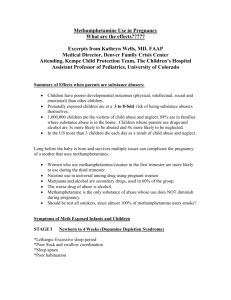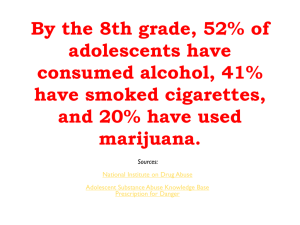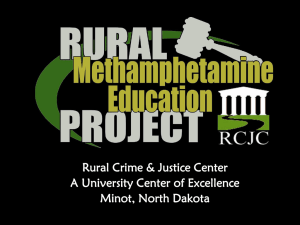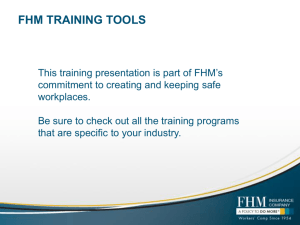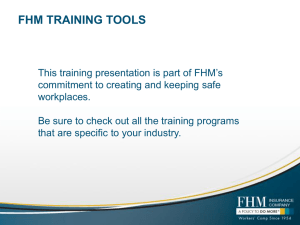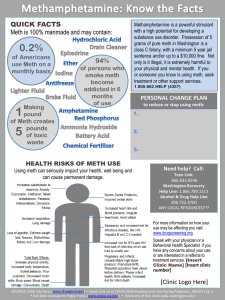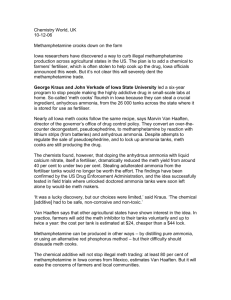Methamphetamine, Pregnancy and Child Development: What We Know
advertisement
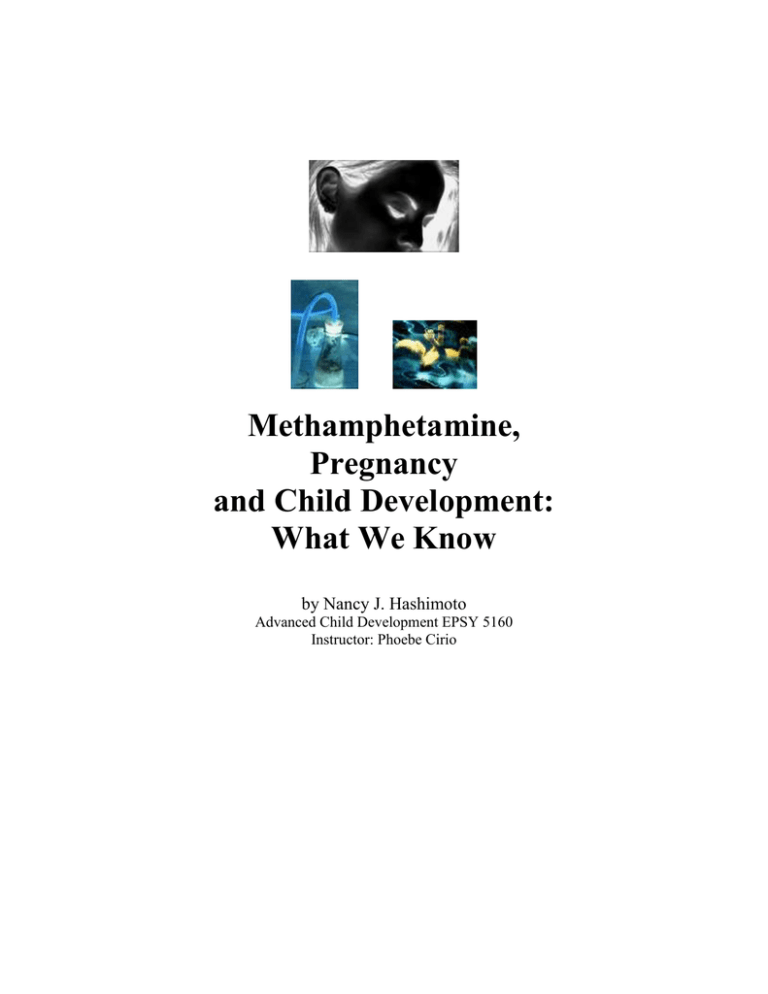
Methamphetamine, Pregnancy and Child Development: What We Know by Nancy J. Hashimoto Advanced Child Development EPSY 5160 Instructor: Phoebe Cirio Contents _________________________________________ Cover Page Table of Contents Part I Introduction Thesis Types of drugs Names the drug takes on Spread of methamphetamine Problems of Drug Exposed Babies Psychosocial Risk Factors Complexities of In-home Factors 1 1 1 3 4 4 5 Part II Growing Numbers & Complex Problems Long term viability of studies Other factors impacting studies Risk factors and variables Psychosocial development & discourse Facts and support Figure 1: Developmental Testing Scores 5 6 6 7 10 11 Part III Solutions What to do 10 Conclusion 11 Works Cited 13 Attachment Nancy J. Hashimoto Dr. Phoebe Cirio Advanced Child Development 5160 25 June 2006 Methamphetamine, Pregnancy and Child Development: What We Know Methamphetamine is a class of psychoactive drugs that stimulates the central nervous system. Meth, also called “speed,” “ice,” “crystal,” “chalk,” and “glass,” among other street names, can be ingested several ways including being snorted, inhaled, swallowed, smoked, or injected. In the user, it can cause paranoia, sexual overstimulation, insomnia, anxiety, violent behaviors, stomach cramps, rapid heart beat, heart damage, high blood pressure, shaking and hallucinations. It is also one of the most addictive substances on the streets today and growing because of its easy-to-make accessibility, the strength and duration of its high, and the fact that it is cheap. There are varying types and potencies of methamphetamine. For the purposes of this paper, D-Meth, a controlled substance, will be the specific drug discussed. It rapidly enters the brain and affects the central nervous system. L-Meth, the other type of methamphetamine, is found in over-the-counter drugs and poses no risk to health if used as directed. Meth is similar to cocaine in its effect on the brain because both drugs regulate dopamine which controls the brain’s pleasure censors. Thus, many studies of cocaine’s effect on unborn babies are used as baseline assumptions about methamphetamine’s effects. This report will use some of the same information in Hashimoto 2 instances where graphics and data are used simultaneously for cocaine and methamphetamine effects on children, development and statistics. Although methamphetamine is quickly spreading, it is also “under” studied. While several research programs are underway, including major funded efforts in Hawaii, I intend to show that meth has measurable, proven effects on a fetus, newborns, and has a vast negative impact on children living in the homes of methamphetamine manufacturers and addicts, causing developmental problems that are not necessarily physically passed on, but are a growing danger to children on another level. It should be acknowledged, however, that some of the symptoms drug-exposed children exhibit can be found in children not prenatally exposed. By the same principle, not all children who had in utero drug exposure will exhibit any signs, either at birth or later in life. This begs the question, how common is the problem? Methamphetamine use is a quickly spreading hazard. Both domestic meth production and trafficking are primarily seen in the western and southwestern regions of the United States. Cities with the most severe ice problems include Dallas, Denver, Los Angeles, Phoenix, San Diego, San Francisco, and Seattle. Parts of the northwestern U.S., the Midwest, and parts of the South, especially Georgia and its neighbors, are becoming increasingly rich in methamphetamine supply and usage. The U.S. Department of Health and Human Services has stated that as of 2005, the number of adolescents 12 and up who have tried meth at least once is over 12 million. That number itself is a staggering statement on the dangers to youth as methamphetamine can be highly addictive, often starting with the very first hit. Considering that teens often use the drug to improve libido and sexual Hashimoto 3 performance, the statistical probability of teen pregnancy rises as drug use, accompanied by a feeling of being uninhibited, increases. According to an October 2004 ABC News report, the number of women who use methamphetamine is rising. Men have traditionally been the profile gender for meth use. Now, however, it is estimated that almost 50 percent of meth users are female. This number is significantly higher than women who make up marijuana, cocaine and heroine abusers. Additionally, Court Appointed Special Advocates reports that 7 out of 10 reported child abuse and neglect cases involve parental drug use in some way. The child welfare system is infamously over-loaded and the increasing meth problem is adding fuel to the fire. The number of abused and neglected children has doubled. These children have a 3-4 times greater chance of being abused and/or neglected. To make matters worse, most parents who abuse never seek treatment. Although it is arguable that babies are born “meth addicts,” according to CESAR Methamphetamine Publications, it has become clear in scientific research that meth use of the mother can have both short and long term negative impact on child formation and development. Meth use during pregnancy increases the mother’s blood pressure and heart rate, which, in turn, substantially raises the likelihood of miscarriages or premature delivery. Methamphetamine can also constrict blood vessels in the placenta, restricting blood flow, nutrition and oxygen to the fetus. It can also permeate the placenta itself, leading to prenatal stroke and/or damage to a baby’s major organs. If this occurs, it is Hashimoto 4 reversible; however, chances of birth difficulties can be greatly reduced if the mother stops using meth in the last trimester. Often, babies who have been exposed to methamphetamine while in the womb can exhibit several problems including extreme sleepiness, low weight to due disinterest in food, irritability, jitteriness, and loud, piercing crying. These babies are often hyperreactive to stimuli and tend towards excessive moodiness. There are a few such babies (about 4%, according to the Denver Family Crisis Center) who experience actual withdrawal and need treatment. Generally, these children who have been exposed to meth are also at risk for SIDS, viral hepatitis, and HIV along with the increased chances of being exposed to other potentially harmful STD’s such as herpes or Chlamydia. Newborns may also exhibit a developmentally damaged brain, heart, spinal cord or kidneys. As they grow, these children can begin to display learning disabilities, stunted growth, and other developmental delays that unfold throughout childhood. Other in utero problems can include the actual turning inside-out of the fetus, urogenital problems, skeletal abnormalities including the development of a club foot, visual abnormalities, cleft palates, delayed motor development, rib malformations and gastroschisis among other potential intestinal issues. They may have problems with the natural sucking and swallowing reflexes. In addition, these children may not be able to tolerate certain stimuli such as touch and light. They may have tremors and coordination problems. Long-term, the effects of maternal meth use can last several years. School- aged children can exhibit hyperactivity and ADHD plus unprovoked rage. Hashimoto 5 As Dr. Kathryn Wells of the Denver Family Crisis Center writes, the full effects of maternal meth use on infants is not yet known. She acknowledges major studies way address the issue more fully as the usage of methamphetamine increases within the U.S. population. Psychologist Trecia Wouldes of the University of Auckland in New Zealand also emphasizes the need for further research on the topic. She, too, acknowledges “a growing number of women of childbearing age...using the drug” (1). She goes on to explain, “The widespread use has been reflected in the dramatic increase in referrals of women who have used this drug during their current pregnancy to the Alcohol Drug and Pregnancy Team at National Women’s Hospital In 2001, 10% of the total ADAPT referrals were due to methamphetamine use and associated problems. This escalated to 59% in 2003” (1). She cites a lack of quality long-term studies on this issue and warns against hasty medical and policy-based decisions regarding maternal meth use. Significantly, she does say that the facts that do exist come from (a) animal studies, (b) a limited quantity of human studies and (c) other prenatal studies of abusers of similar drugs (i.e. crack cocaine). Interestingly, similar studies on crack using mothers show little evidence of serious brain damage on babies but definite long-term neurobehavioural effects. As one study points out, it can be difficult to determine whether certain child development problems are caused by actual methamphetamine use or the environment in which the child is conceived and raised. Dr. Wouldes supports this theory citing other “psychosocial risk factors” that may be just as influential as maternal meth use if not moreso, including poverty, dangerous lifestyles, and histories of childhood abuse in the adults involved, including possible sexual abuse. Hashimoto 6 Dr. Wouldes is an authority in this area. She has co-written an article in The New Zealand Medical Journal, along with Linda LaGasse, Janie Sheridan, and Barry Lester, entitled “Maternal methamphetamine use during pregnancy and child outcome: what do we know?”. The article acknowledges an increase in meth use worldwide. It also contains a useful table showing psychological, social, and health problems observed in mothers referred to ADAPT for methamphetamine use: Psychosocial and Health Factors N=34 Multiple drug use/abuse including: cigarettes (33), marijuana (14), alcohol (10), opiates (6)* 33 History of not keeping appointments for antenatal check-ups 14 Mental health problems including psychotic behaviour and attempted suicide 10 Referrals to Child, Young Persons and Family Service 10 Custody issues due to unstable home environment 7 Legal proceedings pending for mother or imprisonment 5 Medical complications prenatally 4 Known history of overdose 2 ADAPT=Alcohol Drug and Pregnancy Team; *Refer to numbers of mothers using that substance. (p. 2, table reprinted from NZMJ 26 November 2004, Vol. 117, No. 126) Still, Dr. Wouldes and her colleagues call for further in-depth and long-term studies on prenatal methamphetamine use’s full effects on physical, cognitive and emotional development. This same study, a major one in its field specialty, sites a 35% rate of cranial abnormalities in both prenatally exposed meth babies and cocaine babies. Female children of drug-abusing mothers were much smaller in stature than their peers. They markedly fell behind in math, language and sports. However, it should also be noted that these results, too, tie in closely with several psychosocial factors in these same families. Hawaii is one of the leading United States which is taking a closer look at the meth problem. Dr. Chris Derauf is a pediatrician at the Kapiolani Medical Center for Women & Children. In 1999, he studied the stools of newborn infants to find out how Hashimoto 7 many were being born with methamphetamine in their systems. He estimated that an astonishing 850 babies are born annually who have been exposed to ice. He is a part of a group who has been granted $6 million by the National Institute on Drug Abuse to conduct a five-year study on the long term effects of prenatal exposure to methamphetamine. Part of the problem Derauf acknowledges, is how to study these children without exposing frightened mothers to the risk of losing their children through Family and Children Services intervention. That has a big effect on the availability and quality of potential data to be gathered accurately and completely. Fortunately, for research purposes the federal government has overridden certain requirements that the researching physicians report familial drug abuse to CPS. That will allow for a more honest and thorough study of prenatal drug exposure by Derauf’s team. The mothers and their at-risk children will be provided with a wealth of resources and care in order to address any potential dangers to the children. In addition to and aside from prenatal developmental impairments that methamphetamine causes, there are the problems caused by children growing up with meth addicted parents and in meth lab households that can also impair development, learning, cognitive and motor skills, and endanger their lives. In Sacramento, the Governor’s Office of Criminal Justice and Planning acknowledges that kids living around in-home meth laboratories are exposed to both immediate and long-term physical dangers plus abuse and neglect, “a hazardous lifestyle” (1), social developmental problems and other hazards. The GOCJP research states that actual chemical exposure, because the Hashimoto 8 toxins in cooking meth ingredients permeate the skin and lungs, can cause headache, nausea, coughing, fatigue, dizziness, lack of coordination, tissue irritation, organ damage including brain, liver, kidney and spleen, immunity deficiencies, and more. The risk of explosions in meth homes is high. Children living around meth are far more likely to suffer from physical and sexual abuse because parents are more violent and careless, increasing the likelihood of parents failing to provide basic nutrition, health care, schooling, proper hygiene techniques, et cetera to their children. In one example of how methamphetamine can influence neglect, police in Seattle found several dead calves in stalls on a remote farm because the meth-addicted farmer had forgotten to feed them. Children in meth situations also often live in homes that have loaded firearms lying around, trip wires, and other rigged dangers in addition to the fact that the shelter itself is often in very poor, hazardous condition. Many times, these homes have no heat and air system, insufficient electrical wiring, no running water or refrigeration, and have infestations of fleas, ticks, roaches, flies and lice. Dangerous protection animals may also be present. Using concrete examples, this same study presented a look at 5 children found in a meth lab, ranging from 1 to 7 years old. They were found in a one-bedroom home with no electricity. Dog feces were found in the children’s play area. Sewage was badly backed up and was found in the tub; the kids couldn’t bathe. There were no beds for them. All had Hepatitis C. The youngest of the 5 had a severely enlarged liver. All had needle marks from playing with syringes. Another 2 year old was found in a similar meth lab with open, weepy sores around her eyes caused from several untreated cockroach bites. Hashimoto 9 Other studies on children exposed to meth in their homes show that they are starved, made to steal, told to lie, forced to do ice themselves, and witness extreme behavior in their parents. These children are frequently traumatized but can bounce back if the problem is caught and they are nurtured in loving, safe homes. An article by Craig Chamberlain, University of Illinois at Urbana-Champaign studies how children actually see and perceive what is going on around them in methamphetamine-exposed environments. The study focuses on psychological effects of children reared in these conditions. The research looked at 18 children, ages 7 to 14, from 12 families. All of the families were involved with Child Protection Services due to the parents’ methamphetamine use. A natural assumption might be that the children’s worst experiences and fears might come from the abuse or neglect they received at the hands of meth-addicted parents. However, in the children’s perception, the worst thing they had experienced had actually been the separation from and loss of their parents due to removal from the home. Children can also acquire the paranoia of their addicted families. When removed from their homes, simple routines and boundaries found in “normal” family life can produce “culture shock” (2) in these same children. There is evidence, as cited in a study by a team at the University of Illinois, in a paper called “In these bleak days: Parent methamphetamine abuse and child welfare in the rural Midwest,” that children from methamphetamine using families develop “antisocial beliefs and practices” (abstract, 1) as well as “psychological, social and educational disturbances” (abstract, 1). Hashimoto 10 All of the available information necessarily leads to the questions, “What do we do, then, with drug-exposed children? How do we work with them? What are solutions to existent problems? What are the experts’ recommendations?” One study states, “...regardless of their health status, all children who have a history of prenatal substance exposure should receive developmental evaluations on a regular basis: at least once during the first six months; at twelve months; and at least every year thereafter until school age. Early identification of social, language, cognitive and motor development problems is essential” (2). The same report goes on to say, of special note, that “supporting a drugexposed child in the course of his life may require advocating vigorously for specialized educational services; providing recreational and employment opportunities that allow a measure of success; educating parents; and providing counseling” (2). Prenatally drug-exposed babies and toddlers respond to several techniques designed to soothe over-stimulated children. These include calm environments (lighting, soft music, etc.), being attentive to the child’s body language, swaddling, use a pacifier, calming baths, infant massage, and gradual increase of time spent in daily developmental activities. Consistency and routine are extremely important, particularly when it comes to the actual caregivers. Parent education is also necessary, particularly when social services is involved and there is opportunity to encourage hands-on parental involvement. What are the hardcore facts with regards to developmental studies? In studies specifically on prenatal cocaine usage, children scored lower on the Bayley Mental Developmental Index (see Figure 1, below). The lag in the these children’s development became particularly noticeable and significant by the age of two. The Mental Development Index (MDI) scores also show lower for cocaine-exposed children, by 6 Hashimoto 11 points on a scale of 100. Close to 14% of cocaine-exposed children scored in the range of mentally retarded, twice the rate of children who were not exposed. However, it should be noted that a control factor that is an undetermined variable in this study is the number and kind of other drugs used by the mothers identified in this research. The fact remains that despite the copious beginnings of meth research, the actual measurements of its affects on prenatally exposed children remain too ambiguous to make a specific set of assumptions about mothers’ usage. My research points to a lack of existing long-term studies to this relatively new and morphing drug. In addition, many of the studies currently being used base their results on cocaine comparisons and/or research that involves a potential variety of complex factors. There is a great deal of ambiguity involved in these studies, including the infant/child’s social environment, the number and type of drugs the mother used and for how long during the pregnancy, lack of prenatal care and other hazardous factors generally present in households in which meth is a factor. Experts are reluctant to make concrete determinations based on the current evidence. The good news is, however, that studies are increasing in number, quality, and length when it comes to prenatal and post-natal meth use in families. We can safely assume, from the studies cited, that meth use is potentially detrimental to pregnancy and child development. The existing evidence plus case studies and common sense point to a complexity of factors that easily lend themselves to a variety of interpretation. Until further, long-term quality studies are completed and compared on parenting and meth use, real conclusions with reliable recommendations are going to be scarce but desperately needed. This is an expanding landscape of institutes Hashimoto 12 Exposed and Unexposed High-Risk Children Tests of mental development at 6.5, 12, and 24 months showed average scores of cocaine-exposed and unexposed children from comparable backgrounds were below the normative score of 100 for children in the general population. At age 2, cocaine-exposed children did significantly poorer in mental development than children in the comparison group. -- Figure 1, Courtesy of National Institute on Drug Abuse and researchers coming together to study the total problem methodically and scientifically. Most of what are now theories will be supported scientifically in time. Real life examples of exposed children exist and grow every day; they become aware and studies will gain the empirical experience of their young wisdom and perceptions. There is no doubt in my mind that methamphetamines can “package” a person from beginning Hashimoto 13 (womb) to end (development and life choices). In this regard, we truly must realize that any sort of meth use in family environment is empirically known to be destructive; schools support this notion every day. But there is help and research is increasing with the boom in methamphetamine use, often combined with other drugs. Some questions remain unanswered; the most significant long-term judgments are yet to be drawn. Based on the existing evidence, it is certainly scientifically and observably viable to say that methamphetamine is potentially destructive, to extreme degrees, in both mother and child. The toxins alone used to produce this deadly chemical are in themselves unadvisable at best for pregnant women. These dangers plus studies that have been done lead to the reasonable conclusion that meth is harmful, in a variety of forms, to children, both unborn and developing. Hashimoto 14 Works Cited Blakeman, Karen. “Children of Ice: Meth-exposed babies studied.” The Honolulu Advertiser: 16 September 2003. Chamberlain, Craig, ed. “Study elicits ‘child’s eye’ view of methamphetamine use and its effects.” University of Illinois, Urbana-Champaig, Illinoise: 12 June 2006. “Defining Methamphetamine.” Article. Minnesota Department of Health Methamphetamine Program: April 2005. “Go Ask Alice” at www.crystalrecovery.com. Q & A format. Governor’s Office of Criminal Justice Planning, “Multi-Agency Partnerships: Linking Drugs with Child Endangerment.” Sacramento, California: 28 December 2004. Haight, Wendy, Teresa Jacobsen, James Black, Linda Kingery, Kathryn Sheridan and Cray Mulder. “In these bleak days: Parent methamphetamine abuse and child welfare in the rural Midwest.” University of Illiniois, Urbana-Champaig, Illinois: 2004. “Leading Doctors, Scientists, and Researchers Request that Media and Policymakers Stop Perpetuating ‘Meth-Baby’ Myth.” CESAR Methamphetamine Publications. University of Maryland, College Park: Vol. 14, Issue 33. 15 August 2005. “Methamphetamine Exposure and Pregnancy.” Essay. http://dec.co.riverside.ca.us/fyi/pregnancy.htm “Methamphetamine: A Growing Domestic Threat.” Drug Enforcement Agencies Publications. The National Center on Addiction and Substance Abuse at Columbia University, “Casa releases No Safe Have report”. Press release. 11 January 1999. North Dakota Department of Health. “New mother fact sheet: Methamphetamine use during pregnancy.” October 2002. Schabner, Dean. “Meth Use by Women on the Rise.” Article. ABC News. 25 October 2004. Shah, Rizwan, MD, FAAP. “Children: The Real Victims of Meth Exposure.” Essay. Blank Children’s Hospital, Des Moines, Iowa. Singer, L.T. “Cognitive and Motor Outcomes of Cocaine-Exposed Infants.” Abstract. National Institute of Drug Abuse, JAMA, 1952-1960, 2002. Wagner, Chris. “Totally ‘Methed’ Up.” Essay. The Center for Youth Understanding: 2005. Wells, Kathryn, MD. “Methamphetamine and pregnancy.” Essay. Denver Family Crisis Center. Wouldes, Trecia. “Exposure to methamphetamine in the womb causes adverse developmental effects.” Medical Studies/Trials. 29 November 2004. Wouldes, Trecia, Linda LaGasse, Janie Sheridan, and Barry Lester. “Maternal methamphetamine use during pregnancy and child outcome: What do we know?”. The New Zealand Medical Journal, Vol. 117, No. 1206. 26 November 2004. Attachment Credit -- Excerpt: Rizwan Shah, MD, FAAP Blank Children’s Hospital Des Moines, IA 50309 Common Symptoms in Infants who were Perinatally Exposed to Drugs Diagnosis: Hypertonicity (increased muscle tone) Possible Causes: Overdrive of the brain’s response for muscle action Expected Course: Birth until age 12 months or longer Possible Treatments: 1. Passive Range of Motion (ROM) exercises 2. Infant Massage (handout) 3. May require referral to therapy services 4. Avoid walkers at any age. Exersaucers and jumpers when tone has stabilized and OK’d with physician, then use these items for limited amounts of time. Diagnosis: Tremors of arms and/or legs (shaking) Possible Causes: Overdrive of the brain’s response to muscle action Expected Course: Birth until 12 months or longer Possible Treatments: 1. Minimize overstimulation 2. Stress reduction 3. May refer to OT/PT Diagnosis: Irritability/excessive crying Possible Causes: Poorly organized brain response to external stimuli Expected Course: May be present at birth and may last until age 12 months Possible Treatments: 1. Avoid overstimulation 2. Provide a consistent stable environment 3. Swaddle in blanket 4. Offer pacifier Diagnosis: Poor self regulation of feeding (infant wanting to eat all the time) Possible Causes: Poorly organized brain function Expected Course: 0 to 4 months of age Possible Treatments: 1. Talk with pediatrician to determine optimal caloric needs of infant 2. Offer bottled water between feedings 3. Offer pacifier for nonnutritive suck Diagnosis: Poor self regulation of feeding (difficult to get infant to feed) Possible Causes: Infant is too sleepy or tuned out and does not wake for feedings, takes too long to feed or infant has poor suck/swallow coordination. Poor sensory integration. Expected Course: 0 to 4 months Possible Treatments: 1. Discuss optimal caloric needs with physician 2. May need to wake child every four hours to assure child is meeting caloric guidelines 3. May need to try different nipples on the bottle until find one that works for the infant 4. May need a referral to therapy services for a feeding evaluation Diagnosis: Poor self regulation of sleep/wake cycle (infant sleeps “all the time”) Possible Causes: Poor brain regulation Expected Course: 0 to 6 months Possible Treatments: 1. Minimize overstimulation 2. Establish sleep time routines Diagnosis: Trunkal muscle weakness Possible Causes: 1. CNS injury 2. Positional effect from back to sleep position Expected Course: Varied Possible Treatments: 1. Encourage supervised play on tummy 2. Supportive positioning (handout) 3. May refer to OT/PT Diagnosis: Various medical complications such as: 1. Neurological complications such as stroke or seizure 2. Infectious diseases such as Hepatitis A, B, C, or HIV Possible Causes: 1. Insult to CNS 2. Perinatal exposure to infectious agent Expected Course: Varies with proper medical intervention Possible Treatments: 1. Proper medical intervention and therapies 2. Use of universal precautions on all children in foster care, respite care and daycare Possible Symptoms in Toddlers and Preschool Age Children who were Perinatally Exposed to Drugs Diagnosis: Speech problems (speech may be unclear for age or child may not be using the number of words appropriate for age) Possible Causes: Toxic effects on brain centers for speech Expected Course: Varied Possible Treatments: 1. May refer for a speech and hearing evaluation when indicated 2. Encourage interactive reading at home 3. Encourage child to use words before honoring his/her request 4. Encourage sign language communication early on Diganosis: Temper tantrums/aggressive behavior Possible Causes: 1. Normal toddler behavior 2. Poor communication in speech delayed children 3. Direct response to stress in the environment 4. Toxic effects of perinatal drug exposure Expected Course: Varies Possible Treatments: 1. Teach sign language for expression of feelings (i.e., I’m mad, I’m sad) 2. Redirect behavior 3. Use positive, non-punitive reinforcement 4. Reframe the behavior as a mode of expression Diagnosis: Sensory integration issues (aversion to cuddling, touching, issues around new clothes, shoes, bath time, new environments) Possible Causes: Poor development of sensory brain function Expected Course: Varies Possible Treatments: 1. May refer for sensory integration evaluation and treatment through OT 2. Avoid triggers for sensory defe nsiveness Potential Symptoms in School Age Children who were Perinatally Exposed to Drugs Diganosis: Attention Deficit Hyperactivity Disorder Possible Causes: 1. Direct result of drugs on brain function 2. Environmental factors Expected Course: Varies Possible Treatments: 1. AAP Recommendations for ADHD: a. Medical treatment combined with behavioral therapy is the most effective b. Efficacy of medical treatment in drug exposed children has not been studied. Therefore each individual case needs to be evaluated regarding benefits versus risks of medication. c. Medication alone is not a recommended treatment for ADHD. d. Behavior treatment recommended by the AAP includes: i. Managing undesirable behaviors by positive reinforcement ii. Better communication between school and home iii. Special classroom management for behavior modification iv. Summer and Saturday programs Diagnosis: Social Maladjustment Possible Causes: 1. Sensory integration problems 2. Developmental disorders (i.e., PPD, Autism) 3. Secondary to environmental deprivation 4. Direct toxic effect of drugs such as alcohol Expected Course: Varies Possible Treatments: 1. Individual and group therapy 2. Neuropsychological evaluation, looking at the relationship between brain function and behavior 3. Assessment for underlying psychiatric disorders 4. Environmental interventions to improve environment 5. Sensory integration therapy Diagnosis: Academic failure Possible Causes: 1. Intellectual delay 2. Learning Disability Expected Course: Varies Possible Treatments: 1. Same as for social maladjustment 2. Classroom modification
